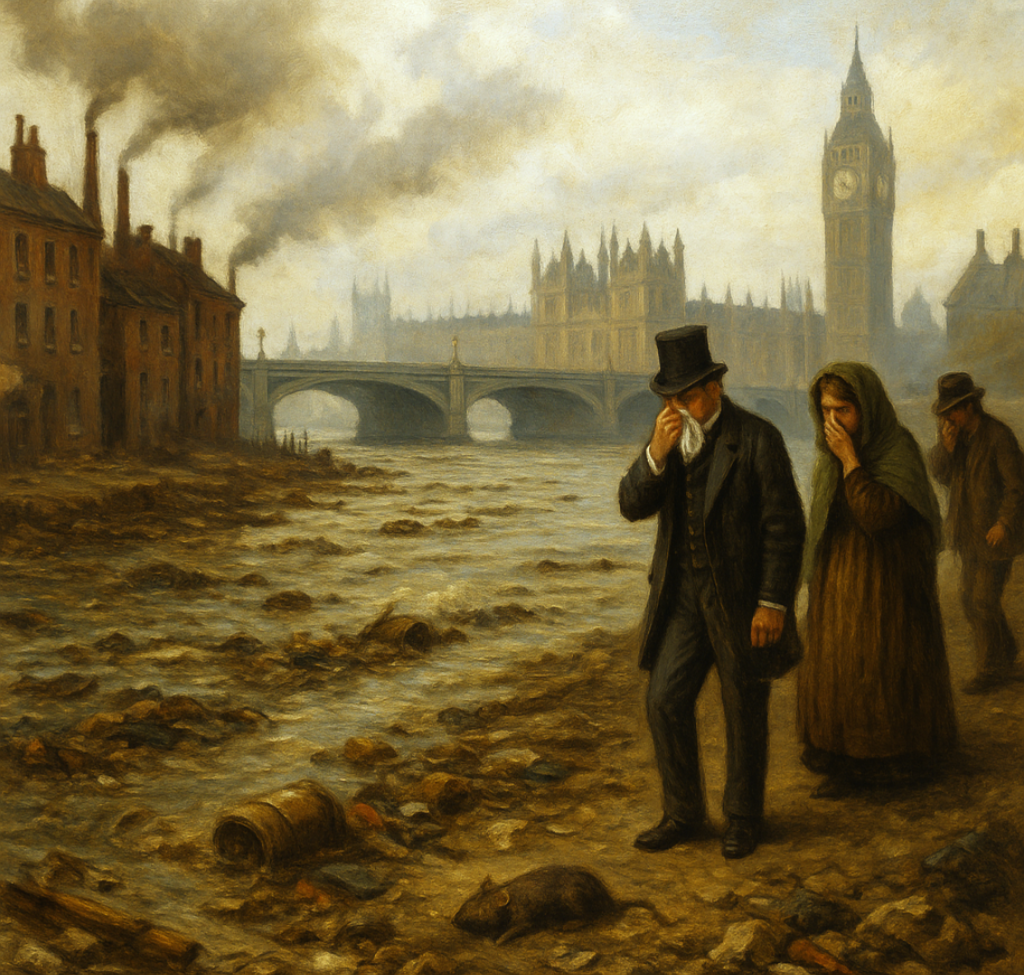The Great Stink and Its Causes
The summer of 1858 marked a significant crisis for London, often referred to as the Great Stink of London. The capital was engulfed by an overwhelming odor emanating from the Thames River, which had become the city’s primary disposal site for sewage and industrial waste. As the heat intensified, the river’s level decreased, exposing the accumulated filth and exacerbating the stench that pervaded the air. This event was not merely a public nuisance but a crucial turning point that led to substantial changes in urban planning and public health policies.
Causes of the Great Stink
Several factors contributed to this infamous odor crisis:
* Rapid Urbanization: The Industrial Revolution had propelled London’s population to nearly three million by the late 19th century, creating increased waste that the existing infrastructure could not handle.
* Outdated Sanitation Systems: Prior to the Great Stink, London depended on a series of cesspools and open sewers that discharged waste directly into the Thames River.
* Climate Conditions: A hot summer led to low water levels in the Thames, revealing the rotting waste below the surface.
The combined effect of these factors led to a public health emergency that was underscored by the overwhelming stench permeating the city. Newspapers reported on the crisis, warning of the potential health risks associated with the conditions, thus fostering public anxiety and concern.
Detailed Analysis of Its Impact on Urban Infrastructure
The Great Stink served as a wake-up call for London’s authorities and ultimately revolutionized urban infrastructure in multiple ways.
Immediate Reactions
As the smell became unbearable, public figures, including the influential medical officer John Snow and the social reformer Edwin Chadwick, recognized the urgent need for reform. Snow’s work on epidemiology highlighted the link between contaminated water and disease, while Chadwick advocated for a new sewage system based on a fresh-water model similar to that of Paris.
Establishment of Modern Sewage Systems
One of the most significant outcomes of the Great Stink was the implementation of a modern sewage system. The government commissioned the famous civil engineer Joseph Bazalgette to design a comprehensive sewer network. Bazalgette’s revolutionary approach included:
* Separation of Sewage and Rainwater: The new design divided sewage from stormwater, preventing both types от flooding during heavy rains.
* Pipe Network: Bazalgette constructed over 1,000 miles of sewers, using gravity to transport waste away from the city and towards treatment facilities located far from populated areas.
* Pump Stations and Treatment Works: His system included pumping stations that moved sewage to treatment facilities where it was dealt with before being released into the Thames at more acceptable locations.
This design not only tackled the immediate effects of the Great Stink but also laid the foundation for the modern sanitation system in London, which continues to serve as a model for other cities worldwide.
Improvements in Public Health Policies
The Great Stink also catalyzed public health reforms that recognized the inseparable link between sanitation and community welfare. Key changes included:
* Public Health Act of 1848: Although the Act was in existence before the Great Stink, it was largely ineffective until public disaster prompted enforcement. The Act led to the establishment of local boards of health, serving as watchdogs for public sanitation.
* Development of Clean Water Supply: Greater investment in clean water supply was initiated, with funds allocated to develop wells and reservoirs to provide fresh water, reducing reliance on potentially contaminated sources.
* Creation of the Metropolitan Board of Works: Established in 1855, this body was tasked with managing urban infrastructure, paving the way for systematic urban development and governance.
These reforms led to measurable public health improvements, as mortality rates from waterborne diseases such as cholera began to decline significantly in the years following the implementation of these changes.
Lasting Effects and Lessons Learned for Modern Urban Planning
The impact of the Great Stink of London extends beyond immediate fixes to a lasting legacy of urban planning principles and public health consciousness that resonates today.
Urban Infrastructure Resilience
The experience of the Great Stink demonstrates the importance of infrastructure resilience in urban planning. Modern cities, often facing similar challenges of rapid population growth and urbanization, can draw valuable lessons from London’s approach. Key insights include:
* Holistic Urban Management: London shifted from reactive measures to proactive planning, focusing on integrated approaches that include waste management, water supply, and health services.
* Adoption of Technological Innovations: Strategies developed in response to the Great Stink, such as the use of gravity-fed drainage systems and advanced sewage treatment methods, were prioritized, leading to the development of more technologically sustainable urban environments.
Public Health Advocacy
The Great Stink also highlighted the need for strong public health advocacy and community involvement. Building upon lessons learned, modern urban planners must:
* Incorporate Community Feedback: Including local voices in planning processes ensures that the solutions address community-specific conditions and helps maintain public trust.
* Prioritize Environmental Health: Continued emphasis on the interrelation between environment and health remains crucial, necessitating sustainable practices that preserve quality of life for residents.
The Role of Smell in Urban Development
An often-overlooked aspect of urban planning is the role that olfactory experiences can impact urban life. Understanding how odors influence community wellness is essential for an inclusive approach to modern city development. Cities today can benefit from:
* Mitigating Unpleasant Odors: Investment in urban greenery, improved waste management protocols, and public awareness campaigns on sanitation can ensure that odorous nuisances are minimized.
* Recognizing the Cultural Significance of Smells: Urban planners should also appreciate that specific odors can evoke feelings of nostalgia or identity and can be reimagined in positive contexts to enhance urban spaces.
Conclusion
The Great Stink of London is a historic example of how a crisis related to odor can catalyze profound changes in urban infrastructure and public health policy. The lasting effects of this crisis pushed London into an era of progressive sanitation reforms that reshaped its urban landscape and set essential precedents for public health advocacy. The lessons learned from the Great Stink continue to resonate today, reminding urban planners, policymakers, and communities alike of the vital interplay between environmental management and the health of urban populations. Thus, the relationship between smells and urban development is not merely a historical curiosity but an insightful lens through which to view and improve our modern cities.
FAQ Section
What was the Great Stink of London?
The Great Stink of London refers to a public health crisis that occurred in the summer of 1858 when the smell of untreated sewage in the Thames was so overwhelming that it spurred significant public concern and action.
How did the Great Stink impact urban planning?
The Great Stink led to the establishment of modern sewage systems and sanitation practices, as well as public health reforms that recognized the connection between waste management and community health.
What were some key reforms resulting from the Great Stink?
Key reforms included the construction of a comprehensive sewer system designed by Joseph Bazalgette, the establishment of local boards of health, and significant investments in clean water supply.
How can we learn from the Great Stink for modern urban planning?
Modern urban planning can learn from the Great Stink by emphasizing resilience, integrating community involvement, promoting public health advocacy, and recognizing the significant impact of odors on urban environments.
What is the significance of smells in urban environments today?
Smells can significantly influence the perception of urban spaces, impacting mental health and community identity. Understanding this relationship can help enhance the quality of life in urban settings.


